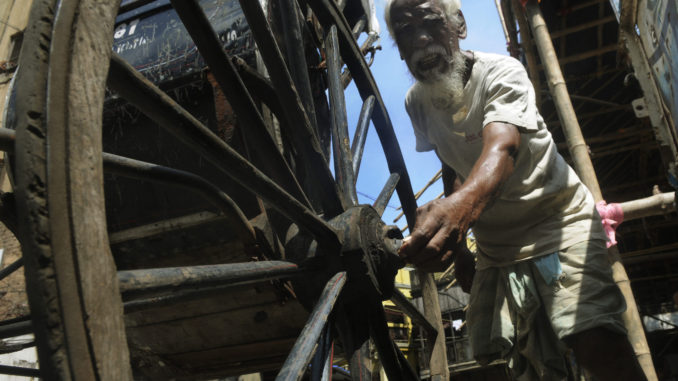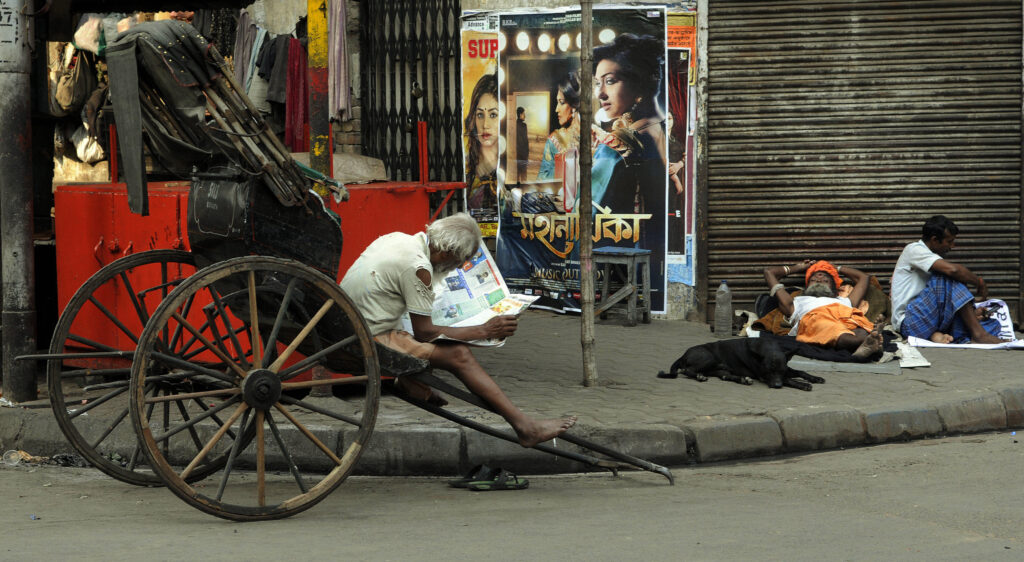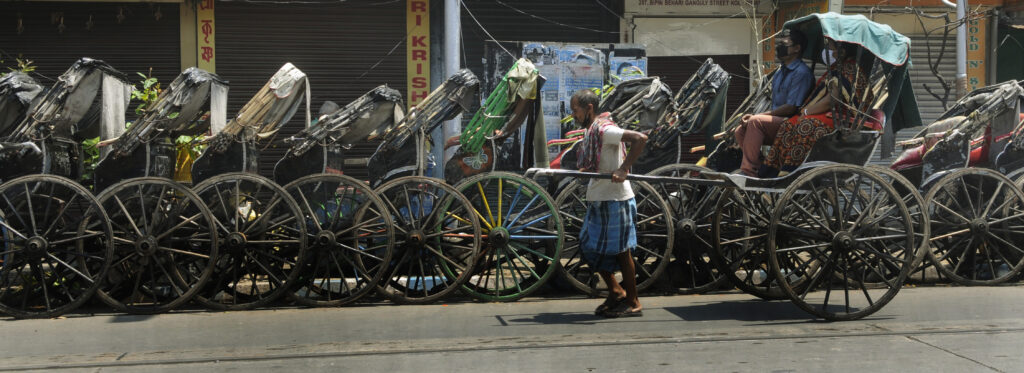
.Mohammed Rafique fled Aurangabad, a district in India’s eastern state of Bihar, seven decades ago after killing a Hindu ‘Rajput’ (a member of the traditional warrior caste), after a fight over religion. Rafique was 10 years old when he first came to Kolkata.
Ferrying passengers on his hand-pulled rickshaw, the 82-year-old has witnessed the change in the landscape of the City of Joy. Interestingly, Kolkata was still under British rule and was known as Calcutta when Rafique first stepped foot in the city.
He came from a well-off family, owning eight acres of land and cornfields, but abandoned it all the day he decided to travel to Kolkata alone. A daily commuter in the central neighborhood of Kolkata, he ferries people from Bowbazar to Sealdah.
However, things have been rough for him. Since Rafique has no other way to earn, it is a compulsion for him to pull the rickshaw.
“I hardly earn INR 10-20 ($0.14-0.28) a day. Nobody hitches a ride these days. With what I earn, it is very difficult to save and then send it back to my family,” he said.
Trams, hand-pulled rickshaws, and old buildings in Kolkata are the legacies of the British. These rickshaws are lightweight and made of wood. They stand as a socio-economic contrast to the modern infrastructure of flyovers and skyscrapers.

The first hand-pulled rickshaw was seen in Shimla, a city in the northern state of Himachal Pradesh, in 1880. It was introduced to Kolkata in the late 19th century. The British government enforced the Calcutta Hackney-Carriage Bill in 1919 that allowed people to board the vehicle.
“In the colonial period, these rickshaws mainly commuted in the Burrabazar area,” said Mahua Sarkar, a professor of History at the Jadavpur University, Kolkata. “Initially, it helped the shops transport goods from one place to another. Later, it became widespread in the entire city. The rickshaw pullers preferred to travel through lanes and not on wide streets,”
She said there were no signs of these rickshaws in and around the “White Town” — places like Park Street and Chowringhee — which housed the British.
“They wer mostly seen near the “Black Town,” especially on the lanes of north Kolkata, where the Zamindars and middle-class families resided,” she said.
The British introduced these rickshaws to exercise racial supremacy over the Indians. Rickshaw pulling, however, was a boon to the poor Indians and immigrants from Bangladesh who came during the 1971 Liberation War.

Sarkar claimed these rickshaws have a legacy and should not go extinct. But, she also pointed out that the rickshaw pullers are fighting for their livelihood as times have changed.
“Rickshaws are a part of Kolkata’s heritage; however, they are also inconvenient in a modern city,” Sarkar said. “Most of the rickshaw pullers are migrants who came from Odisha and Bihar. The income of these pullers have dwindled and it has become difficult for them to survive.”
In 2005, the communist Left Front government tried to take the rickshaws off the streets, claiming they were a perversion to human dignity. In 2006, the Calcutta Hackney-Carriage (Amendment) Bill was passed by the Calcutta High Court. It led to loud protests, not only from the rickshaw-pullers but also from the citizens.
“No new registration or renewal of old registrations are being done for hand-pulled rickshaws,” said Subrata Bandopadhyay, an inspector with the Traffic Guard department. “Since they were once registered under the Calcutta Hackney-Carriage Bill, we refrain from taking action against them and allow them to ply on humanitarian grounds.”
He said the number of hand-pulled rickshaws in Kolkata is the same as it was in 2007.
After the Trinamool Congress came into power in 2010, the then mayor Sovan Chatterjee declared that civic bodies would be issuing ID cards to these rickshaw pullers. The Mamata Banerjee-government later decided to replace the city’s 6,000 rickshaws with battery-powered vehicles.
While the Kolkata Municipal Corporation (KMC) assisted the registration of about 6,000 hand-pulled rickshaws and 285 pullers got listed with the Kolkata Police, the rickshaw union claimed the number of rickshaw pullers was around 24,000, with a dependency of 120,000. It turned out the battery-powered rickshaws became an extra burden for them, as most of them could not afford without governmental subsidy.
“These are all political gimmicks played by the politicians,” said Rafique. “During the elections, they come pleading to us for votes. They will even salute us. But once the election is over, they are nowhere to be found.”
He could not afford to buy a rickshaw and hence rented it from “Khokababu” — a rickshaw puller — who owns more than 400 hand-pulled rickshaws. The union has stopped operating for quite some time now.
Kolkata will never be the same without its rickshaw pullers. It has been portrayed as the lifeline of the city in many books and films. In countries such as Singapore and Malaysia, these rickshaws have been turned into tourist attractions, and it wouldn’t be a bad idea for Kolkata to follow suit.
(Edited by Uttaran Das Gupta and Gaurab Dasgupta.)
The post Kolkata’s Hand-Pulled Rickshaws Are a Dying Legacy appeared first on Zenger News.
